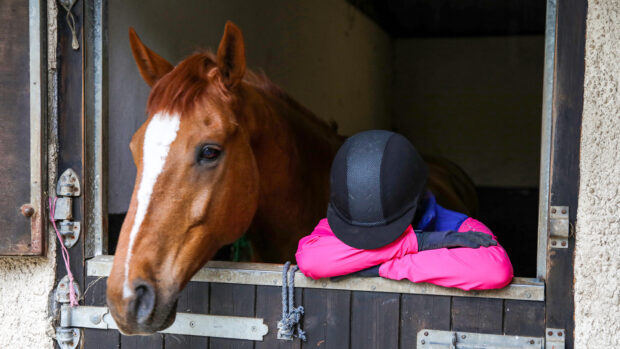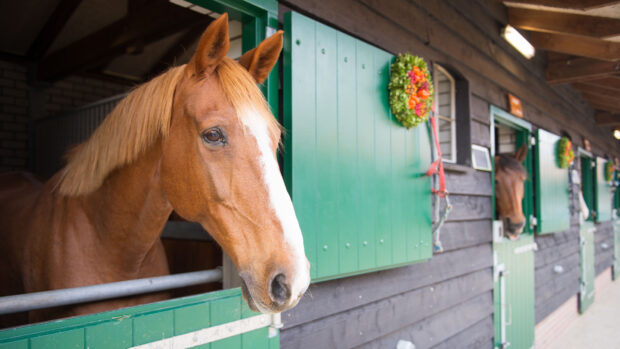There is such a variety of bedding materials on the market to choose from, but the best horse bedding is quite individual to you and your horse. Depending on whether you need to prioritise budget, muck-out speed, absorbency, low dust levels or sustainability, the best bedding for you is likely to be something different from your horse’s stable-mate.
In contrast to the old days of the choices being straw or shavings, there is now a wide range of wood-, paper- and plant-based options. Some are scented, while others boast sustainable qualities – the choices are endless. The science behind horse bedding has come on over recent years and no matter where you’re based, it’s possible to find a solution. If you are looking for a bedding that’s free of prohibited substances look out for the BETA NOPS accredited bedding and find out why it is important to you and your horse.
Ready to make a change? Jump down to read about the advantages and disadvantages of different types of horse bedding to help you decide what might work for your horse.
What’s on the market?
NB: Although the RRP listed is for a single bag, actual price will vary with location and size of purchase.
Blue Ribbon Premium Wood Pellets
Material: Wood pellets
Bale size: 15kg
Bales to fill 12x12ft stable: 9
RRP: From £7.99
This sustainable bedding from Blue Ribbon is made in the foothills of Snowdonia from FSC-certified timber. It is described as easy to use, super-absorbent, with a fresh pine smell and is naturally antibacterial.
Caviera Raviera Lavender
Material: Rape straw
Bale size: 20kg
Bales to fill 12x12ft stable: 2–3
RRP: From £9
This chopped, dust extracted, premium rape straw bedding from Caviera has added essential lavender oil, which smells great but also has a harmless bittering agent to discourage bed eating. It is described as highly absorbent, quick to muck out and fast rotting.
AW Jenkinson Natural Flake Shavings
Material: Shavings
Bale size: 17kg
Bales to fill 12x12ft stable: 4-6
RRP: From £7.50
Described as premium quality. These dust extracted shavings are highly absorbent. The large softwood flakes help create a comfortable, cushioning bed for your horse.
Easibed Wood Fibre
Material: Wood fibre
Bale size: 20kg
Bales to fill 12x12ft stable: 8
RRP: From £8
Easibed is a dust-free, supportive bedding made from clean recycled wood that provides a comfortable and free-draining bed for your horse. It is described as economical as you can use less than you would with traditional beddings such as shavings and straw, which saves time, too.
Sorbeo Wood Pellets
Material: Wood pellets
Bale size: 18kg
Bales to fill 12x12ft stable: 5–6
RRP: From £7.07
This sustainable bedding from Sorbeo is made in the UK from locally-sourced timber. It is described as super-absorbent, cost effective and easy to use. Sorbeo also operates a bag recycling scheme.
Nedz Bed Eco
Material: Wheat and rape straw
Bale size: 20kg
Bales to fill 12x12ft stable: 4–5
RRP: From £8.50
This highly absorbent, low-dust blend of wheat and rape straw is treated with a pine scent. It rivals shavings for absorbency and creates a comfortable bedding. It’s biodegradable.
Strawmax Straw Pellets
Material: Straw pellets
Bale size: 15kg
Bales to fill 12x12ft stable: 6–8
RRP: From £6.50
This straw pellet bedding from Bedmax is described as dust-extracted, economical, easy to use and highly absorbent. It is odour-supressing bedding and easy to compost. Made from 100% traceable British straw. BETA NOPS accredited.
Green Mile Equine Performance Bedding
Material: Cardboard
Bale size: 18kg
Bales to fill 12x12ft stable: 3–4
RRP: From £7.50
This virgin corrugated cardboard bedding from Green Mile supports a healthy respiratory system. It is dust-extracted and can hold 10 times its weight in liquid, meaning it’s highly absorbent.
Aquamax
Material: Wood pellets
Bale size: 18.1kg
Bales to fill 12x12ft stable: 8
RRP: From £9.95
Made from pure pinewood fibre. These dust-extracted pellets are sourced from sustainable forests. Described as highly absorbent and biodegradable. With natural antiseptic properties and helps to eliminate ammonia.
Bed-Down Excel
Material: Straw and shavings
Bale size: 10kg or 20kg
Bales to fill 12x12ft stable: 5-6
RRP: From £7.50
Made from chopped wheat straw and shavings.Described as dust-extracted and biodegradable. Free draining it absorbs the wet into a small area. With a fresh lemon fragrance which is naturally unpalatable to discourage bed eating and helps to repel flies.
Types of horse bedding
1. Straw
Advantages:
- Cheap
- Breaks down to produce good garden manure
- Creates a thick, comfortable bed
Disadvantages:
- Bulky and messy to store
- Soon makes a large muck heap
- Can be difficult to dispose of, particularly if you are running a large yard. Cost of disposal can offset initial inexpensive price
- Some horses are allergic to it
- Some horses like to eat it
2. Chopped straw
Advantages:
- Dust-extracted
- Treated to be non-palatable
- Wrapped bales are clean and easy to handle and store
- Not as bulky as straw, so produces a smaller muck heap
Disadvantages:
- More expensive than straw, although cost is reduced with bulk deliveries
- Sold through selected stockists
3. Straw pellets
An eco-friendly bedding made from 100% straw. The fresh straw is dried to high temperature, dust-extracted and then compacted into pellets.
Advantages:
- Dust-extracted
- Highly absorbent
- Eco friendly
- Bags are easy to handle and store
Disadvantages:
- You may need to add water when the bedding is put down, which adds time
4. Wood shavings
Purpose-produced shavings are a popular type of bedding, but the quality can vary enormously — particularly with regards to dust content. It is important that you only buy shavings that have been specifically produced as animal bedding.
Advantages:
- Non-palatable
- Widely available
- Wrapped bales are clean and easy to handle and store
Disadvantages:
- Can be difficult to dispose of – shavings take much longer to rot down
- Needs constant removal of droppings and care has to be taken to ensure the bed does not become wet, causing a build up of ammonia
- Cheaper brands can contain high dust levels
- Price can fluctuate

Wood pellet bedding before watering
5. Wood pellets
These are made from heat-treated and compact sawdust. To use them, water has to be added to fluff them up and increase their absorbency.
Advantages:
- Eco-friendly
- High absorbency
- Dust-extracted
- Composts quicker than shavings or straw
Disadvantages:
- Can be slippery while still in pellet form
- Need to add water when the bedding is put down, which adds time

Hemp bedding
6. Hemp/flax
Bedding material made from the chopped stems of hemp or flax offers an alternative to shavings and paper.
Advantages:
- More absorbent than shavings
- Dust-extracted and non-palatable
- Light and easy to muck out
- Rapidly breaks down to make good compost
- Wrapped bales are clean and easy to handle and store
Disadvantages
- Bales are relatively expensive and the initial cost of bedding down are off-putting
- Manufacturers claim that long-term use make it competitively economical
7. Paper/Cardboard
This tends to be a mixture of newspaper, magazine and other unwanted printed matter. It is often considered to be a cheaper option, but a large number of bales may be needed to create a thick bed. It is also worth considering cardboard, which has similar advantages to paper but is heavier and so less likely to blow around the yard.
Advantages:
- Dust-extracted and non-palatable — a good choice for allergy-suffering horses
- Produces a warm bed
- Wrapped bales are clean and easy to handle and store
Disadvantages:
- Can be costly
- To start a bed it can take five bales, and then one or two bales a week for a horse that is stabled at night
- Easily blown around, producing an untidy-looking yard
- Disposal can be a problem
- Care has to be taken to ensure bed does not become soggy
What is the best bedding for a wet horse?
For horses who are messy and require a lot of fresh bedding, you should look for a more affordable, high-absorbency bedding, such as pellets or hemp, to help keep down costs as well as soak up urine effectively.
How can I save money on horse bedding?
You need to shop smart. Ask friends on the yard and see if they want to split an order with you as most companies will offer a bulk-buy discount. You could also try planning ahead and stocking up for your winter bedding in the summer to avoid the seasonal price increases.
You may also be interested in…
Thinking about swapping your straw or shavings for wood pellets? Here's what you need to consider first...
Rushing from the yard to the office in the morning is often typical for horse owners. Here are some great

16 toys to help horses beat their boredom

Wood pellet horse bedding: what are the pros and cons?

11 top tips to help you survive the stable-to-office dash each morning

10 stable rugs your horse will thank you for

Subscribe to Horse & Hound magazine today – and enjoy unlimited website access all year round















